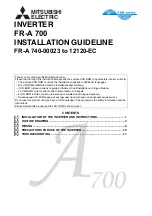
4
3 WIRING
CAUTION
To prevent a malfunction due to noise, keep the signal cables more than 10cm away from the power cables.
After wiring, wire offcuts must not be left in the inverter. Wire offcuts can cause an alarm, failure or malfunction. Always keep the
inverter clean. When drilling mounting holes in a control box etc., take care not to allow chips and other foreign matter to enter the
inverter.
Set the voltage/current input switch in the correct position. An incorrect setting may cause a fault, failure or malfunction.
Source logic
Main circuit
terminal
Control circuit
terminal
Jumper
Jumper
Jumper
*1. DC reactor (FR-HEL)
Remove the jumper
for the 01160
or less if a DC reactor is connected.
The DC reactor supplied with the
01800 or more should be connected
to these terminals.
*2
Earth
*7 The CN8 connector is provided with the
1800 or more.
Motor
*2 To supply power to the control circuit
separately, remove the jumper across
R/L1–R1/L11 and S/L2–S1/L21.
Connect the power to the terminals
R1/L11 and S1/L21 then.
3-phase AC
power supply
Connector for
with/without internal
EMC filter
Main circuit
Control circuit
Terminal functions vary with
the input terminal
assignment.
(
Pr. 178 to Pr. 189
)
Control input signals (No voltage input allowed)
Forward
rotation
start
Reverse
rotation
start
Start
self-holding
selection
High speed
Medium speed
Low speed
Multi-speed
selection
Jog mode
Second function selection
Output stop
RESET
Terminal 4 input selection (current input selection)
Selection of automatic restart after
instantaneous power failure
Contact input common (Sink*)
*3 JOG terminal can be
used as pulse train input.
Use
Pr. 291
to select
JOG/Pulse.
24VDC power supply/ max. 100mA load current
Contact input common(Source*)
*(Common for external power supply transistor)
Frequency setting signal (Analog)
Auxiliary
input
Terminal 4
input
(Current
input)
0–5 V DC
0– ±10 V DC
4–20 mA DC
0 to 10 V DC
4 to 20 mA DC
0 to ±5 V DC
0 to 5 V DC
0 to 10 V DC
PU
connector
Connector for
plug-in option
Option connector 1
Terminating
resistor
*5 The input area can be set via
parameters. The setting within
the frame is pre-set at the
factory.
(Pr. 73, Pr. 267)
.
Set the voltage/current input
switch in the OFF position to
select voltage input (0 to 5 V
or 0 to 10 V) and in the ON
position to select current input
(0/4 to 20 mA).
*6 It is recommended to use a 1 k
Ω,
2 W
potentiometer when the frequency setting
signal is changed frequently.
Relay output 1
(Alarm output)
Relay output 2
Running
Instantaneous
power failure
Up to frequency
Overload
Terminal functions
vary with the output
terminal assignment.
(
Pr. 195, Pr. 196
)
Terminal functions
vary with the output
terminal assignment.
(
Pr. 190 bis Pr. 194
)
Frequency detection
Open collector output common
Sink/source common
Analog current output
(0 to 20 mA DC)
Analog signal output
(0 to 10 V DC)
RS485 terminals
Data transmission
Data reception
(Permissible load
current 100mA)
Frequency setting
potentiometer
1 k
Ω
,1/2 W,
M
3~
Earth
Brake unit
(Option)
*8 Brake resistor (FR-ABR)
Remove the jumper across terminal
PX–PR when connecting a brake resistor
(00023 to 00620).
Terminal PR is provided for the 00023 to
00620. Install a thermal relay to prevent an
overheat and burnout of the brake resistor.
*4. AU terminal can be
used as PTC input
terminal.
*5 Voltage/current
input switch
Option connector 2
Option connector 3
Relay output
USB
connector
Open-Collector output
Summary of Contents for 700 Series
Page 18: ...14 TROUBLESHOOTING ...























